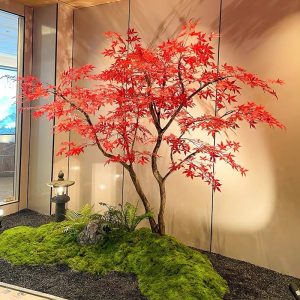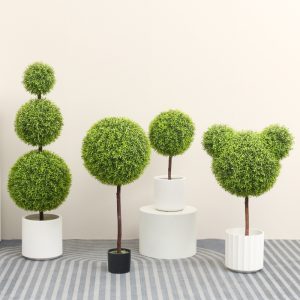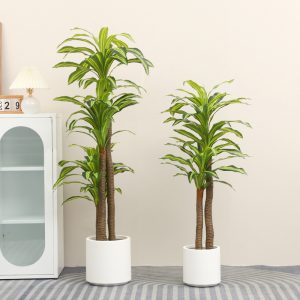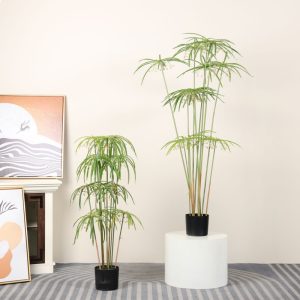At seven in the morning in Barcelona, the late autumn sunlight is streaming through the arched glass windows of a fusion-style restaurant in the Gothic Quarter, casting delicate patches of light on the terracotta floor tiles. The restaurant designer, Carlos, and I stand in the newly completed dining area, watching as the waitress Marisa gently brushes the branches of the central plant arrangement. The long, slender leaves sway gently in the breeze, like countless green ribbons dancing. “The liveliness of this artificial Ficus salicifolia tree is amazing,” Carlos can’t help but reach out to catch a falling “leaf,” surprised by the soft and flexible touch he feels. “Last week during the soft opening, three regular customers asked me if it was a real tree flown in from Southeast Asia. No one noticed it was artificial.”
The restaurant is filled with the aroma of freshly ground coffee beans and Spanish ham, blending with the scent of freshly baked seafood paella to create a warm morning atmosphere. In the five-meter-high space, several artificial Ficus salicifolia trees stand in front of the natural stone wall in the dining area, arranged at varying heights. The tallest one near the entrance has a gray-brown trunk with natural mottled textures, and its hanging branches are covered in slender willow-shaped leaves. The deep green leaves have a matte finish, creating the effect of a flowing green waterfall under the morning light. The most captivating part is the half-open private room divider, where the branches of the artificial Ficus salicifolia tree hang over a woven rattan screen, with the light from a brass chandelier filtering through the leaves, casting moving shadows on the linen tablecloth. The artificial Ficus salicifolia tree used in this restaurant is delicately weaving an image of nature and tranquility for diners.

Light and Texture: The Spatial Magic of the Artificial Ficus Salicifolia Tree
As we walk across the dining area towards the terrace, Carlos suddenly stops in front of a nautical-themed mural: “Look at the hanging arc of the branches, even the distribution of the leaves is identical to the real Ficus salicifolia tree.” I lean in for a closer look and notice the delicate natural curl at the edges of the leaves, the clear veins on the leaf surface, and even the faintly fuzzy texture, just like a plant freshly transplanted from the tropical jungle. As the sunlight slants through, the dark green leaves filter the light into a soft green glow, and as the branches sway, the shadows on the floor move like dancing sprites, creating a living natural painting.
The bar area is even more thoughtfully designed. In this natural-themed space with a walnut wood bar and wicker bar stools, a corner artificial Ficus salicifolia tree stretches its branches, with the slender leaves hanging in front of a liquor shelf, perfectly complementing the colorful liqueur bottles. Bartender Javier shakes a sangria with a smile: “Since we replaced the plants with these artificial plants, we no longer have to clean leaves out of the glasses every day.” He gently moves a branch, and the whole tree sways gently. “What’s surprising is the customer feedback—many people said the swaying greenery makes the bar feel like a ‘little jungle tavern.’ Even the tropical cocktails sales have increased by 30%.”
In the afternoon, at the window-side booth area, sunlight filters through sheer curtains, casting hazy light spots on the cotton and linen carpet. In the middle of the two round tables, an artificial Ficus salicifolia tree in a flower stand is stretching its branches, while a group of friends take photos of their desserts. The phone camera unwittingly captures the swaying shadows of the leaves in the frame. I notice that the connection between the branches and the trunk is designed to appear naturally forked, with even a few half-yellow “withered leaves” scattered among the branches, perfectly replicating the natural growth state of a real Ficus salicifolia tree. “When we used real Ficus salicifolia trees before, the leaves would become brittle and curl up after just three days of air conditioning,” said waitress Ana as she walked by with a watering can. “These artificial Ficus salicifolia trees don’t need watering, and the flexibility of the leaves is more stable than real plants. Customers always say, ‘This tree looks so full of life.'”
Practical Choice: Why Quality Restaurants Prefer Artificial Ficus Salicifolia Trees
“When we first suggested using artificial plants, the owner was worried that we would lose the natural charm,” Carlos said, rubbing the faux bark on the trunk as he recalled the early controversy in the project. “He thought ‘fake plants’ wouldn’t match the restaurant’s ‘natural wildness’ concept, until we did a three-week comparison experiment.” He points to the comparison pictures in the storage room: the real Ficus salicifolia tree had yellowing leaves and drooping branches in the air-conditioned room; regular artificial Ficus trees had stiff leaves and reflected glaring plastic shine under direct sunlight; but this set of artificial Ficus salicifolia trees, made with high-polymer environmentally friendly materials, not only had branches that spread naturally but also exhibited a dynamic aesthetic that was even more layered than real plants under different lighting conditions.
Restaurant manager Lucia, holding the maintenance record, came over and revealed the deeper advantages. In the narrow corridor between the kitchen and dining area, several small artificial Ficus salicifolia trees are placed along the wall-mounted flower racks. The branches do not become greasy or wilt from the oil fumes and steam. “There’s no natural light here year-round, and the real Ficus salicifolia trees would only last a month at most,” Lucia said, wiping the leaves with a soft cloth. “These artificial Ficus salicifolia trees have been treated to be oil- and water-resistant. A quick wipe and they’re clean, which is crucial for maintaining restaurant hygiene standards.” She flipped through the cost sheets and smiled, saying that since they switched to the artificial Ficus salicifolia trees, the cost of plant maintenance had dropped by 65%, saving nearly 8,000 euros a year.
Procurement consultant Marta, presenting the inspection reports in the office, emphasized: “When selecting plants, safety and compliance are the bottom line for B2B clients in Europe and the U.S.” She pointed to the EU environmental certification on the report, saying that the materials used in these artificial Ficus salicifolia trees are free from formaldehyde and allergens, ensuring they are completely safe even if children tug on the branches. “Last week, a guest with a baby left a comment saying her child loves grabbing the ‘hanging green leaves,’ and she checked and found that the leaf edges were very smooth, with no risk of injury,” Marta added. This combination of dynamic aesthetics and safety is exactly the quality that commercial buyers value most.
Dawn and Dusk: The All-Day Aesthetic of the Artificial Ficus Salicifolia Tree in the Restaurant
The restaurant takes on a charming vibe when night falls. Warm yellow wall lights hang from the vaulted ceiling, casting a golden edge on the leaves of the artificial Ficus salicifolia tree. The main tree at the entrance is illuminated by spotlights, and its deep green leaves appear to be dusted with fine gold powder. The hanging branches gently sway with the breeze, and the art lighting on the wall creates a soft, rhythmic movement. Night shift manager Pablo says, “At night, guests love taking photos by these trees, especially couples, who say the shadows of the leaves look like ‘tropical rainforest stars under the moonlight.'” He pulls up some customer social media posts, and even in the dim light, the artificial Ficus salicifolia tree retains its lively posture, without the rigid look of ordinary artificial plants.
In the early morning, the kitchen is bustling with breakfast preparations. The small artificial Ficus salicifolia tree in the corner continues to stretch its branches. Pastry chef Sofia, kneading dough, says: “When we had real Ficus salicifolia trees, the steam from the kitchen would make the leaves stick together, and we were worried about water leaking onto the oven.” She points to the leaves on the branches: “Look at the density of these artificial leaves, even the cold air from the fridge makes them sway naturally.”












